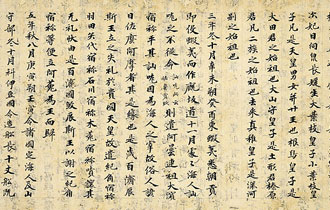Kofun
Large tombs of mounded earth built mainly for the ruling elite during the 4th to 7th centuries. Ranging in size from 15 meters (50 feet) in diameter to 32.3 hectares (80 acres) in area, these tombs are an important source of information on the social and political organization and material culture of the Kofun period (ca 300-710). Early tombs had either round or keyhold-shaped mounds and were constructed on hilltops overlooking fertile agricultural land. Burial facilities consisted of a wooden coffin placed in a pit-style stone chamber. Clay cylinders and various funerary sculptures (haniwa) were often embedded over the grave. In the late 4th century, tombs assumed a greater variety of shapes. In the 5th century the character of the tombs changed drastically: instead of being built on natural hillocks, they were mounded up from flatter terrace surfaces and wide moats became a common feature. Tombs of the 6th and 7th centuries shrank in size and increased in number as they came to be used by a greater sugment of the population. With the introduction of Buddhism in the mid-6th century, an increasing number of the elite built temples instead of tombs for posterity, and tomb building gradually ceased during the 7th century. (adapted from Japan: An Illustrated Encyclopedia. Tokyo: Kodansha, 1993)
There is currently no content classified with this term.











